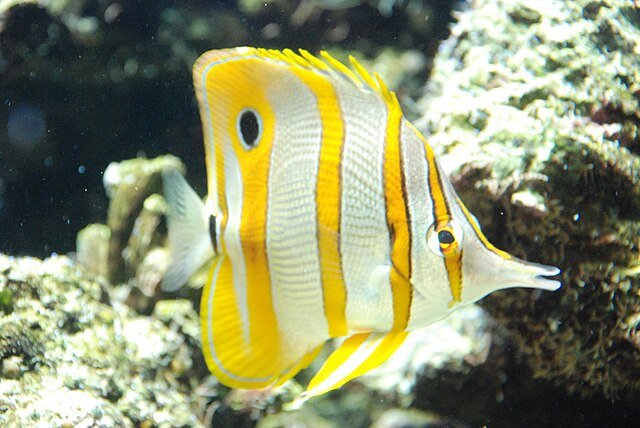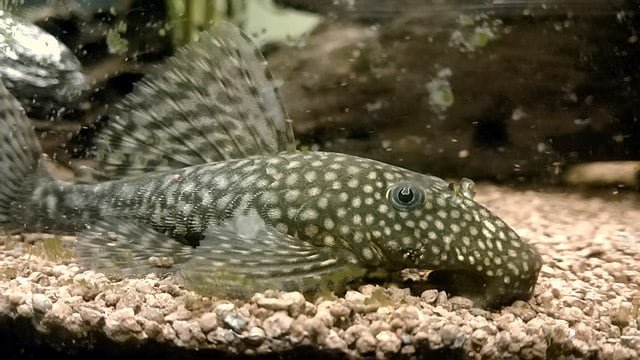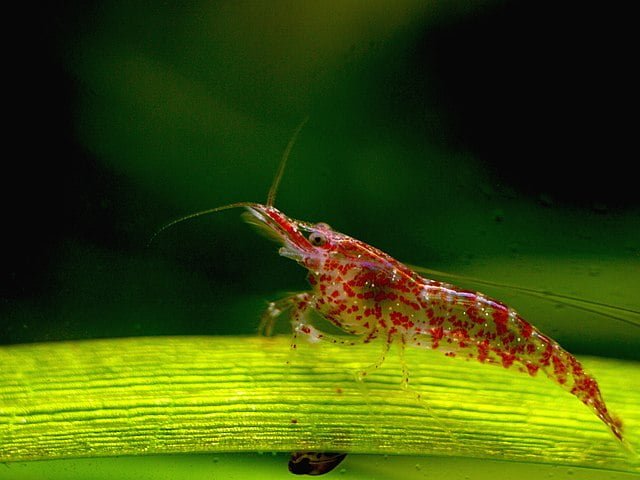
The Copperband Butterflyfish (Chelmon rostratus), also known as the Beaked Butterflyfish, is a fascinating addition to saltwater aquariums, standing out for its vibrant yellow-orange bands and distinctive elongated snout. However, despite its beauty, its care is complex and requires special attention, making it a challenge, particularly for inexperienced hobbyists.
In this comprehensive guide, we will explore everything about Copperband Butterflyfish care, its diet, and compatibility with other species to ensure a healthy aquarium environment.
Taxonomy
- Domain: Eukaryota
- Kingdom: Animalia
- Phylum: Chordata
- Class: Actinopterygii
- Order: Perciformes
- Family: Chaetodontidae
- Genus: Chelmon
- Species: Chelmon rostratus
- Common names in Spanish: Copperband Butterflyfish, Pez Mariposa de Bandas Cobrizas, Pez Mariposa de Nariz Alargada, Pez Mariposa de Banda de Cobre, Pez Mariposa de Hocico Largo.
- Common names in English: Copperband Butterflyfish, Beaked Butterflyfish, Beaked Coralfish, Orange Stripe Butterfly, Banded Long-snout Butterflyfish, Longnosed Butterflyfish.
Copperband Butterflyfish can live up to 10 years. On the other hand, Wang et al. (2014) determined the complete mitochondrial (mt) genome of the Copperband Butterflyfish Chelmon rostratus from Beibu Bay, China, which consists of 13 protein-coding genes, 22 tRNA genes, 2 rRNA genes, and a control region. Additionally, Huang et al. (2019) assembled the genome of C. rostratus, while Suyu et al. (2023) published the Copperband Butterflyfish genome, which comprises 24 chromosomes assembled at the chromosomal level.
Physical Characteristics
Copperband Butterflyfish (Chelmon rostratus) can reach a maximum length of 20 cm (8 inches). Additionally, the Copperband Butterflyfish has a laterally compressed body with a long snout, four parallel orange bands with an eyespot on the posterior dorsal fin, and a black band at the base of the tail. It also has nine dorsal spines, 28 to 30 soft dorsal rays, three anal spines, and 19 to 21 soft anal rays.
Natural Habitat
The Copperband Butterflyfish (Chelmon rostratus) inhabits the tropical waters of the Indo-West Pacific Ocean: Northwestern Australia/Great Barrier Reef to northern Papua New Guinea, northwestern Andaman Sea, and the Ryukyu Islands. They are commonly found in coral reefs or rocky areas, where they use their slender snouts to forage for food in crevices. These fish live in a depth range of 1 to 25 meters.
In their natural habitat, Copperband Butterflyfish feed on small invertebrates such as worms, crustaceans, and marine sponges.
Copperband Butterflyfish Care
The Beaked Butterflyfish is suitable for large reef tanks or community fish-only aquariums but requires careful consideration when kept in reef tanks with soft and stony corals due to its potential to nip at certain corals and invertebrates.
Additionally, maintaining stable water conditions in the tank is essential for the health of the Beaked Butterflyfish, as they are highly sensitive to environmental changes. To ensure their well-being, it is necessary to maintain optimal water parameters, as shown in Table 1.
Table 01. Water Quality Parameters for Copperband Butterflyfish (Chelmon rostratus) Care.
Stay Always Informed
Join our communities to instantly receive the most important news, reports, and analysis from the aquaculture industry.
| Parameter | Range |
| Tank Size | Minimum of 280 liters (75 gallons) for one fish, 475 liters (>125 gallons) or more for multiple fish |
| Water Temperature | 24.7 – 29.3, average 28.5°C (75–78°F) |
| Water pH | 8.1 and 8.4 |
| Specific Gravity | 1.020—1.026 |
| Nitrates | < 25 mg/L |
| Water Change | 20 – 30% per month |
| Tank Substrate | Fine sand or crushed coral |

Copperband Butterflyfish Diet
One of the most challenging aspects of caring for this fish is its diet. In its natural habitat, the prominent snout of the Copperband Butterflyfish allows them to reach small crevices in reefs in search of prey, which includes anemones (Aiptasia sp.), polychaete worms, small crustaceans, and occasionally coral polyps.
The Copperband Butterflyfish is a selective feeder, which can make feeding in captivity difficult. They need a varied diet that resembles what they consume in their natural environment, such as small invertebrates.
Recommended Foods:
- Live foods: Mysis shrimp, brine shrimp, black worms, and small mussels.
- Frozen foods: Shrimp and other meaty foods, preferably soaked in garlic or vitamin-enriched water.
- Supplements: Adding vitamins and fatty acids can improve the fish’s health and appetite. Garlic is especially useful for stimulating feeding.
It is recommended to feed adult fish three times per day, while younger fish require more frequent feeding.
Copperband Butterflyfish Reproduction
Copperband Butterflyfish are sexually distinct, displaying slight sexual dimorphism. Chelmon rostratus forms pairs and is monogamous. These fish are oviparous and spawn in open waters around coral reefs.
Ruensirikul et al. (2016) investigated the sexual dimorphism, mating, and spawning of Copperband Butterflyfish (Chelmon rostratus) in captivity. Here are the main findings:
- Sexual Dimorphism: The study found significant differences in snout morphology between males and females. Males have a small hump-like protrusion and a steeper slope than females, allowing for accurate identification (83.33% for males and 100% for females).
- Mating: The mating experiment revealed that the control group (T1) had the lowest acceptance rate (16.67%), while the other treatments (T2-T5: time of introducing the male or female into the breeding tank) had higher rates (40-100%). This suggests that allowing the fish to interact for a week before mating can improve mating acceptance.
- Spawning: Researchers achieved a pair of Copperband Butterflyfish after raising them for 12 months. The pair spawned seven times, producing between 1,940 and 2,780 eggs per spawn. The eggs were pelagic, with a diameter of 663.00 + 17.04 μm and a single oil globule of 132.60 + 6.30 μm.
- Larval Development: Newly hatched larvae had a total length of 1.36 + 0.02 mm, with their mouths opening at 2 days old, measuring between 83 and 110 μm. The yolk and oil globule were completely absorbed by days 3 and 6, respectively. Head spination near the pelvic fin extended by day 10.
Compatibility
The Copperband Butterflyfish is generally considered reef-safe, although it may nip at small invertebrates like shrimp if not adequately fed. They may also graze on algae and consume problematic organisms like Aiptasia, making them useful for pest control. However, they should not rely solely on this for their diet, as they require a more varied intake.
The Copperband Butterflyfish is a peaceful species that can coexist well with other non-aggressive species in a community tank. However, they should not be housed with other butterflyfish, as competition for territory and food may lead to aggressive behaviors.
Suitable tank mates include small, reef-safe fish such as gobies, anthias, and certain wrasses. Care should be taken when introducing aggressive species like triggerfish or puffers, as they may stress or harm the Copperband.
Health Issues
The Copperband Butterflyfish is prone to common saltwater aquarium diseases such as marine ich and marine velvet, due to their sensitivity to water quality and stress. Regularly monitoring water parameters and maintaining a clean environment is crucial to prevent outbreaks. Additionally, a balanced diet and stress-free surroundings play an important role in preventing diseases.
Common Diseases:
- Marine ich (Cryptocaryon irritans)
- Marine velvet (Amyloodinium ocellatum)
- Lymphocystis: This disease may resolve within a few weeks by improving water conditions and providing a stress-free environment.
Conclusions for Successful Copperband Butterflyfish Care
To successfully keep a Copperband Butterflyfish (Chelmon rostratus), the aquarist must provide a well-maintained tank with stable water conditions and a varied, protein-rich diet. Regular water testing, a high-quality filtration system, and careful selection of tank mates are essential to ensure the long-term health of these delicate but beautiful fish.
Understanding their unique requirements and replicating their natural environment will allow you to enjoy the beauty and grace of the Copperband Butterflyfish in your aquarium.
References
Huang, X., Song, Y., Zhang, S., Yunga, A., Zhang, M., Chang, Y., … & Liu, S. (2019). Chromosome-level genome assembly of a butterflyfish, Chelmon rostratus. bioRxiv, 719187.
RD Stuart-Smith, GJ Edgar, AJ Green, IV Shaw. 2015. Tropical Marine Fishes of Australia. Reed New Holland.
Ruensirikul Jirayuth, Mavit Assava-aree, Atra Chaimongkol, Sirawan Bunchai and Khwantana Ongart. 2016. Sexual Dimorphism Identification, Response to Paring Manipulation and Spawning in Captivity of Copperband Butterflyfish, Chelmon rostratus (Linnaeus, 1758).
Suyu Zhang, Yue Song, Meiru Liu, Zengbao Yuan, Mengqi Zhang, He Zhang, Inge Seim, Guangyi Fan, Shanshan Liu, Xin Liu, Chromosome-level genome of butterflyfish unveils genomic features of unique colour patterns and morphological traits, DNA Research, Volume 30, Issue 5, October 2023, dsad018, https://doi.org/10.1093/dnares/dsad018
Wang, L. J., You, F., & Wu, Z. H. (2014). Complete mitochondrial genome of copperband butterflyfish Chelmon rostratus (Teleostei, Perciformes, Chaetodontidae). Mitochondrial DNA Part A, 27(3), 2141–2142. https://doi.org/10.3109/19401736.2014.982596
Editor at the digital magazine AquaHoy. He holds a degree in Aquaculture Biology from the National University of Santa (UNS) and a Master’s degree in Science and Innovation Management from the Polytechnic University of Valencia, with postgraduate diplomas in Business Innovation and Innovation Management. He possesses extensive experience in the aquaculture and fisheries sector, having led the Fisheries Innovation Unit of the National Program for Innovation in Fisheries and Aquaculture (PNIPA). He has served as a senior consultant in technology watch, an innovation project formulator and advisor, and a lecturer at UNS. He is a member of the Peruvian College of Biologists and was recognized by the World Aquaculture Society (WAS) in 2016 for his contribution to aquaculture.




